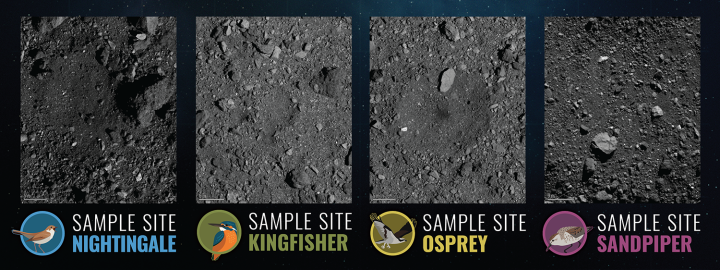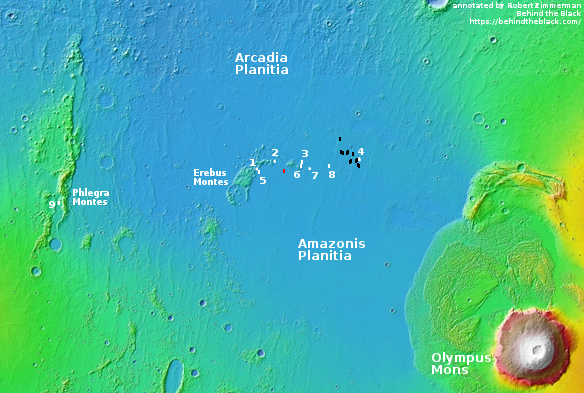OSIRIS-REx completes reconnaissance of four candidate sample sites
OSIRIS-REx has completed its high resolution reconnaissance of the four candidate sites on the asteroid Bennu, chosen for possible sample capture during touch-and-go operations planned for the summer of 2020.
In the next few days the science team will decide which of these four sites, shown above, will be the primary and back-up landing locations. The decision however appears challenging, based on the information gathered.
Bennu has also made it a challenge for the mission to identify a site that won’t trigger the spacecraft’s safety mechanisms. During Recon A, the team began cataloguing Bennu’s surface features to create maps for the Natural Feature Tracking (NFT) autonomous navigation system. During the sample collection event, the spacecraft will use NFT to navigate to the asteroid’s surface by comparing the onboard image catalog to the navigation images it will take during descent. In response to Bennu’s extremely rocky surface, the NFT system has been augmented with a new safety feature, which instructs it to wave-off the sampling attempt and back away if it determines the point of contact is near a potentially hazardous surface feature. With Bennu’s building-sized boulders and small target sites, the team realizes that there is a possibility that the spacecraft will wave-off the first time it descends to collect a sample.
Based on the information at the link, plus the presentation by Dante Lauretta, OSIRIS-REx’s principal investigator, given at the asteroid conference I attended in November, I suspect that Nightingale will be primary landing site.
Regardless, it appears the science team has recognized that the landing will difficult, and will likely require multiple attempts before the spacecraft’s navigation system lets it happen.
OSIRIS-REx has completed its high resolution reconnaissance of the four candidate sites on the asteroid Bennu, chosen for possible sample capture during touch-and-go operations planned for the summer of 2020.
In the next few days the science team will decide which of these four sites, shown above, will be the primary and back-up landing locations. The decision however appears challenging, based on the information gathered.
Bennu has also made it a challenge for the mission to identify a site that won’t trigger the spacecraft’s safety mechanisms. During Recon A, the team began cataloguing Bennu’s surface features to create maps for the Natural Feature Tracking (NFT) autonomous navigation system. During the sample collection event, the spacecraft will use NFT to navigate to the asteroid’s surface by comparing the onboard image catalog to the navigation images it will take during descent. In response to Bennu’s extremely rocky surface, the NFT system has been augmented with a new safety feature, which instructs it to wave-off the sampling attempt and back away if it determines the point of contact is near a potentially hazardous surface feature. With Bennu’s building-sized boulders and small target sites, the team realizes that there is a possibility that the spacecraft will wave-off the first time it descends to collect a sample.
Based on the information at the link, plus the presentation by Dante Lauretta, OSIRIS-REx’s principal investigator, given at the asteroid conference I attended in November, I suspect that Nightingale will be primary landing site.
Regardless, it appears the science team has recognized that the landing will difficult, and will likely require multiple attempts before the spacecraft’s navigation system lets it happen.









